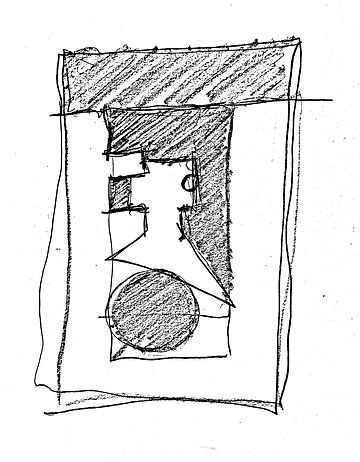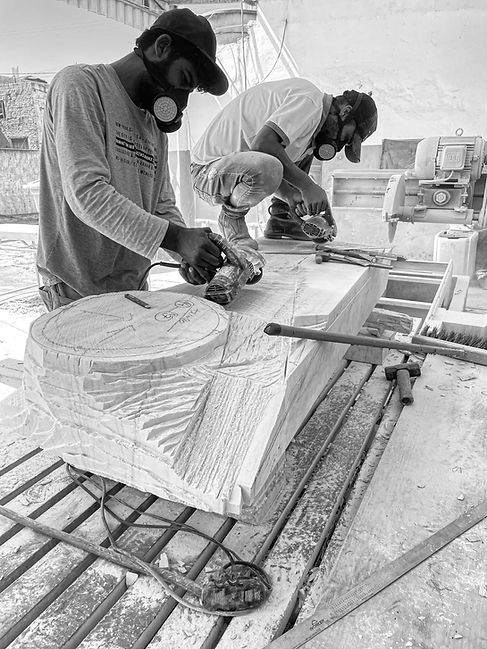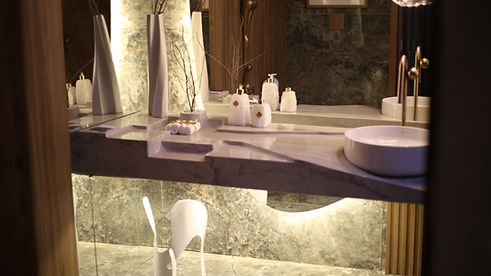Bahia / 2023
Sculpture for the atmosphere by architect Maine Ribeiro.


Creative Process
Uma escultura utilitária. Entre a arte e o Design
At the invitation of Architect Maine Ribeiro, Coríntia designs an exclusive piece for the largest architecture and design exhibition in the Americas.
Coríntia had the opportunity to interpret the spatial intent and desired atmosphere envisioned by the architect, resulting in a unique piece tailored for the exhibition.
Painting | Drawing | Sculpture
The Form Across Artistic Languages
Finding the form of a sculpture that uniquely incorporates function is a process that Coríntia's Head Designer, Guilherme Falcão, discovers through working with various artistic languages.
His background in architecture, where an intimacy between form and function exists, fuels this quest.
The process begins with drawing, painting on canvas, or even working with stone. It involves the interplay of perception and information derived from chromatic contrasts and subtractive sculpting.
A utilitarian sculpture
A New Concept of Art
The creative idea had a series of premises that we had to follow. One of them, as required by the sponsor, Deca, was to use one of their collection's sinks, preventing Coríntia from sculpting it.
Architect Maine Ribeiro, with whom there were several conversations and meetings to understand the presence of the countertop in the space she was envisioning.
The coverings, in porcelain tile, were full of organic forms imitating a natural rock. The highlight was the randomness representing various minerals and a green palette.
The countertop had to be cantilevered, which led to the need to consult a structural engineer, as it would involve between 400 to 500 kg of solid stone in cantilever.
The countertop would appear to levitate, a juxtaposition between the actual weight and apparent lightness. It contrasted with the atmosphere created by the cladding and a darker floor versus the white of the rock. On the left, on the only side communicating with the wall, with the structure, a mirror follows the surface, giving a sense of continuity through reflection. It duplicates the countertop, expanding the perception of space.
What was a small service lavatory is now an exhibition space for a piece of art that can be used.
The geometry of the design sculpted in the stone incorporates Deca's sink. The sculpture is conceived as a composition that only works with these elements. A play of subtractions on the left that will be mirrored by the reflection, creating a moment of greater tension and volumetric complexity. There is a platform that stands out and emerges as the dominant one in the composition, the utilitarian layer that opens up almost embracing the sink. Inviting it to be part of the interplay of volumes. Its circle is balanced in the composition by another smaller circle. A container that will be filled with small stones saved from the cuts that sculpted the piece. Crushed into gravel, they will fill and secure the plants that will exist in the vase sculpted into the same countertop.
The conceptual incorporation of the exhibition's maxim 'Body and Dwelling' was also a motif in creating the piece. 'Body and Dwelling' reminded me of Juhani Pallasmaa's book 'The Eyes of the Skin,' where the Finnish architect argues that to read a space, all senses are necessary, not just vision. The sound of water, which alludes to calmness, locates the sink in the least turbulent part of the countertop. Where there is a plane that sections the volume to emphasize the sink but invites one to run their hand over the unevenness of that plane. The texture of the stone belongs to the composition.
The entire history and volumetric richness of this countertop can and should be read with hands, traversing the entire design.
This perception of space with various senses nourishes the memory created from it, enriches the emotional memory of the place, of home. A piece sculpted in stone is also timeless, due to its geological properties, made from quartzite, it is a piece that will last generations if cared for. It is a piece that will be referenced in the stories told and lived by those who experienced the space, because it will endure, from grandparents to children and grandchildren. A sculpture like those of Coríntia lasts lifetimes and will coexist in the memories of those who use it.




Artisanal Craftsmanship in the Age of Automation
Artisanal
The Artisanal Approach to Sculpting Quartzite in the Age of Automation"
In sculpting quartzite through artisanal methods in today's automated age, the challenge lies in overcoming the hardness of the rock. A rock with such a high degree of hardness necessitates the use of electric or pneumatic tools; traditional tools like chisels and hammers alone are insufficient. We are currently at a pivotal point where artificial intelligence is gradually taking over various manufacturing processes, heralding a significant transition in automation, which has already advanced considerably. CNC machines, mechanical arms, and three-dimensional designs that translate into realistic renders of pieces or environments are becoming prevalent. Technology is sweeping in like a tsunami, altering the industrial landscape much like the revolution of 1760 did during the industrial revolution.
At Coríntia, we want to emphasize the 'Handmade' aspect, crafted with skilled hands. From 'thinking with hands,' as quoted by Alberto Campo Baeza, to materialization - sculpting guided by the mastery and skill of our talented artisans. The majority of our artisans have been trained and developed within Coríntia. Our ambition to reclaim the lost 'handcrafted workforce' following the demise of the cooperative has proven to be challenging, but it remains a long-term commitment for us.

